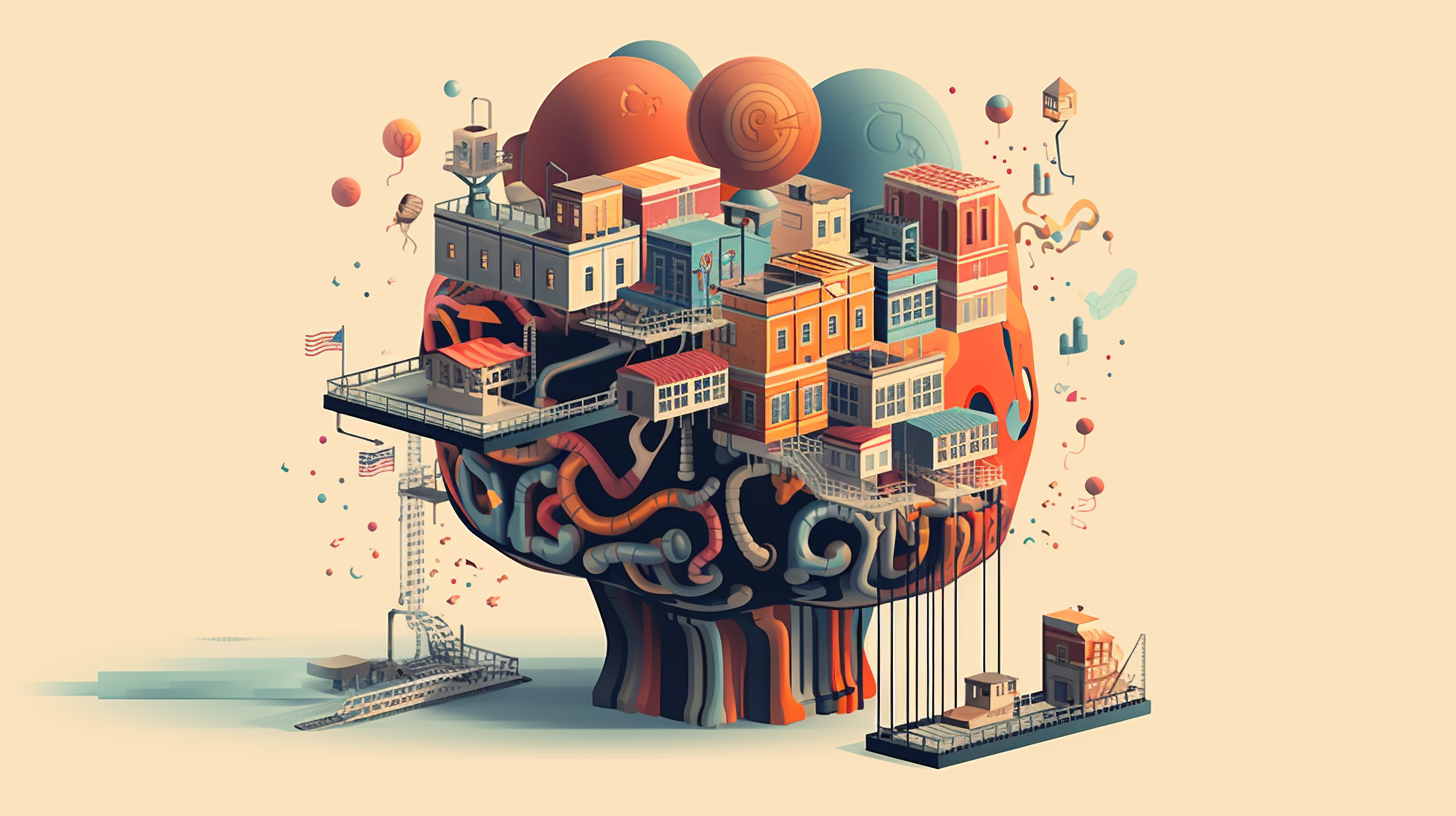What's Wrong With My Brain?
“I saw this thing, it was amazing, let me find it, I’ll show you.” Shoulders hunch, heads lower, two hours of Googling and doom-scrolling emails from 2019 ensue.
How often have you sat at your desk, attended a brainstorm and searched for ideas or instantaneous inspiration? Hoping that something will pop out of the ether. Not only that but whatever does are the best ideas they can be and not tainted by recency bias (what you saw this morning).
AI is everywhere, built, or being built into everything. Its ability to instantly access and succinctly deliver the world’s knowledge can make anyone appear like an expert in a field and ace any test. And the more we feed it, the better it gets. This is rattling our collective cages and upending our most established systems, from law to education. So, now seems a good time to assess where that leaves us. Which skills, as individuals, we want to nurture as unique our own and which we’re happy to outsource to, and to keep up with: “the machines”.
Chatbots are incredibly adept at knowledge recall, consistency, speed and automation. They’re amazing aggregators and splicers of existing information, but they create nothing genuinely new. Ai falls short in areas of creativity, nuance, interpretation and emotion. Once we get over the honeymoon period with Ai, it will be to the human condition what the calculator is to calculus: a tool. One that we employ to expedite our path towards creating and solving new challenges. Like a calculator, Ai is as good as the input it receives.
There’s a satisfying appeal to use tools like Chat GPT, Bard, Dall-E, Midjourney and countless others as an end in itself rather than a means to; whilst this is a great party trick and essential for learning, it’s missing the point. Ultimately, we need to harness Ai and the skills it excels at to give us an edge against the ones it doesn’t. Allowing us to move away from the monotonous heavy lifting to direct our energy towards the nuanced needlework.

Q: If we all have the same answers, what will set us apart?
A: Our difference will be difference. What we as individuals bring to the table, our unique perspective, personality, opinion and ability to eloquently convey, persuade and convince, will set us apart from Ai and our peers.
Enter BASB (building a second brain). BASB is a process, not a product. It’s also not the solution; it’s a part of it. A method of knowledge aggregation, a proprietary database we create to reclaim our brain’s bandwidth, from storing and even recalling, back towards creating. As David Allen, author of Getting Things Done (GTD), puts it, “our brains are for having ideas, not holding them.” The good news is you’ve most likely done 80% of the work required already.
SECOND BRAIN - AT A GLANCE
(1) Enhanced Memory and Information Retention
(2) Increased Productivity
(3) Improved Learning and Creativity
(4) Reduced Cognitive Load
(5) Personal and Professional Growth
What's a Second Brain?
Like everything good, it all started in the 90s. PKM (Personal Knowledge Management) was developed for students that had to deal with the internet coming online and how to make sense of the information overload that ensued. Fast forward, and their “overload” is a veritable trickle compared to our savage onslaught and the ADHD it’s given us. It’s got to the point where it’s so overwhelming we read an article’s title and move on, content we’ve learned something. Superficially, knowing of many topics, but substantially nothing at all. To counter this, a tool or method that’s gained popularity is Building a Second Brain or BASB. BASB is simply a term for something most of us have in hand but take a scattergun approach towards. Knowledge aggregation and utilisation. It creates something extremely valuable that we cannot obtain anywhere else: a personally curated collection of knowledge tailored by you and for you—a gift of concise knowledge, creativity and productivity to your future self.
"A recent Princeston survey found that the jobs least likely to be replaced by Ai are those that involve expressing opinions."
BASB is a methodology for capturing and organising the wealth of information that comes our way. By creating a digital repository, our second brain can help us avoid oversaturation and nurture and make better use of our ideas so we can pour our thinking rather than finding.
Why Do I Need One?
Putting aside that Ai is currently writing its CV for your job, it massively increases productivity, creativity and, most importantly: individuality.
Ultimately a Second Brain nurtures our own critical thinking, which will be a crucial differentiator moving forward in a world dominated by Ai. A recent Princeston survey found that the jobs least likely to be replaced by Ai are those that involve expressing opinions. In other words, the jobs most likely to persist involve promoting or articulating a particular perspective. Our perspective. Our unique take on things will become the value we add, not our ability to do.
Chatbots have no independent thought. They (very impressively) regurgitate existing information. So, having your own curated knowledge to help enhance your competitive edge becomes incredibly valuable. As Ai assistants expand, we’ll see increasingly homogenised opinions where articles, blogs and art become similar as we all call on the same base information. Nuanced and personal experience will be the key to differentiation.
What Can I Do With It?
34GB or 174 newspapers, front to back. According to the New York Times, that’s a person’s daily data consumption. And that’s now! Our brains cannot process, retain and use that quantity of information. We’ve become attention-poor headline-readers. We need to create tools to help us. Luckily that’s one area where we excel. Enter the second brain and, with it, your competitive edge in a world of excellent homogeny.
34GB or 174 newspapers, front to back. According to the New York Times, that's a person's daily data consumption. And that's now!
BASB’s not new, either. For centuries, our best thinkers and philosophers (think da Vinci) carried a “commonplace book” – a collection of ideas and musings they found particularly thought-provoking. Unlike reading today, they approached it with much more fluidity and creativity, reading not from front to back but in fits and starts. They spliced information into new arrangements that resulted in unique thought streams. They were able to draw connection sand parallels where previously there were none. A Second is a commonplace book for the digital age.
SECOND BRAIN - AT A GLANCE
(1) Making our ideas concrete
(2) Revealing new associations between ideas
(3) Incubating our ideas over time
(4) Sharpening our unique perspectives
Outsourcing select mental activities can be a game-changer. By freeing up mental bandwidth, you’ll have more time to focus on the tasks that require your expertise, creativity and, ultimately, your opinion. Let’s start outsourcing.
How to Start?
1. IDENTIFY YOUR ASSETS & VALUES
The first step is to self-audit what you already have, as you likely already possess a wealth of assets. These might include physical or digital notes, Kindle/e-book highlights, physical book highlights/notes, quotes, web reading lists, emails, YouTube videos, Slack channels, WhatsApp messages, Twitter threads, Discord groups and resources saved on Pocket/Instapaper/Read wise etc. Based on these findings, consider the most prevalent inputs you value most and which format will likely be your go-to moving forward. The outcome will help select the second brains of tware.
2. LIBRARIAN, ARCHITECT OR GARDENER (STUDENT)
These are the predominant note-taking personas. Which one you are might be clear-cut or a hybrid (see our article on BASB resources). Your style and needs determine the software you use, of which there are numerous options, both paid and free. We’ve outlined the headliners below, but at the end of the day, the best tool is the one that you’ll use. Don’t worry too much about it being perfect. Pick one and move forward.
3. NOTION - THE CONTORTIONIST
Pros: Insanely flexible. Great for project and task management.
Cons: Insanely flexible, people never stop customising. The interface is not for non-tech savvy. Offline is almost nonexistent.
OBSIDIAN - THE COOL KID
Pros: The cool kid. Incredible bi-directional linking. Amazing graph view (thought cloud). Nonproprietary notes.
Cons: Less established, less integration. Less intuitive. The interface is not for non-tech savvy.
EVERNOTE - THE OG
Pros: The OG of notes. Web clipping, OCR (image-to-text) and built into absolutely everything.
Cons: Best in paid form. Can be a bit slow, the interface is a bit dated.
4. JUST START CAPTURING
Don’t be daunted; just start capturing information. This could include insights from articles or books, thoughts from podcasts, key points from meetings and lectures, or ideas that randomly pop into your head. Aim to distil information into its essence. As brief as possible. This ‘distillation’ forms a core tenet of an efficient second brain.
5. REVIEW & CONNECT
The power of a second brain is not digital hoarding but the capacity to interconnect disparate information. It’s not a static repository: it’s a dynamic, evolving entity. This will involve adding new information, archiving or deleting outdated information, and eventually switching your entire system and software. Don’t be wedded to anything. Be water, my friend.
You’re busy now; you’ll likely be busy in the future. You won’t have time to interpret thousands of words, so distil the essence of notes. Think of it as messaging your future self with info. Think E=mc2.
Look for connections. Neuroscientist Nancy C. Andreasen puts it well, “By keeping diverse kinds of material in one place, we facilitate this connectivity and increase the likelihood that we’ll notice an unusual association.” So, tease out the key points and see how thoughts might link with others. This promotes an enhanced understanding of the subject and the generation of new insights.
Conclusion

1. THE NECESSITY OF A SECOND BRAIN
Today’s quantity of information is impossible to process, retain and creatively apply. A second brain helps to make sense of it all.
2. BENEFITS OF BASB
Outsourcing information retention increases productivity and creativity to foster personal and professional growth.
3. IMPLEMENTING A SECOND BRAIN
Identify our existing assets. Select the appropriate software based on our note-taking persona. Just start, review, refine and put to use.
4. BASB AS A RESPONSE TO THE RISE OF AI
Ai is everywhere, built or being built into everything (including second-brain software). A
second brain not only puts Ai to use for us but does so in a way that strengthens the very nature
of what sets us apart from it. We can’t compete, so don’t try. We must leverage it or get or
replaced.
BASB AS A RESPONSE TO THE RISE OF AI
In an AI-driven world, differentiating ourselves is crucial. Building a second brain helps us leverage AI’s capabilities to our advantage, enhancing our productivity and creativity by freeing up cognitive resources.
Our unique insights and ability to build and harness tools set us apart. A second brain is uniquely equipped for the digital age. Tailored to both leverage and counter Ai. It’s far more than a repository of information.
We need to embrace this paradigm shift. And the paradigm shift after that. Stay current, always. Doing so establishes a symbiotic relationship between our creativity and our Ai tools. They are to creativity what the calculator was to mathematics. Or, to use another analogy, our intellect is a lagging indicator of what information we have been feeding ourselves. Information is like nutrition; we are what we consume.
A personal, curated bank of knowledge comprising your best thoughts, ideas and thinking, on hand, always, for you to call upon and draw from to nurture your creative breakthroughs and give you a creative and competitive edge in a way a generic chatbot never could.
Sounds appealing?
